JONATAN SPEJLBORG IN CONVERSATION WITH TRAVIS WYCHE
I’m restraining myself to say what it is that we’re precisely doing here. Did you have a look at the book? Yes, I’ve been reading it. It’s great. There’s some powerful ideas in there that are highly relevant to the realms I’ve been spelunking through.
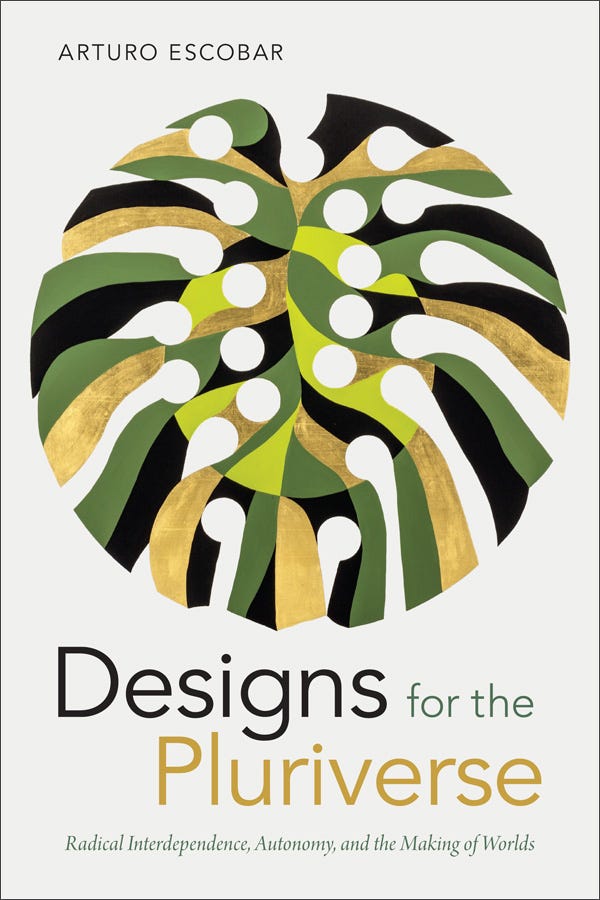
There are certainly ontological and epistemic roots to the problems that we are facing these days. One must take such a statement with a sense of humor as it’s almost incomprehensible to say such a thing to most people and even when someone does understand what you mean by an ontological or epistemic disorder or deficiency it becomes a problem that boggles the mind and strains the imagination due purely to the scale, which is almost beyond scale, certainly beyond the boundaries of polite conversation. This book nicely addresses a few key points concerning how our civilization has organized itself around certain power dynamics and how those dynamics are of a patriarchal descent inflecting a gradual dissociation from each other and with the land itself. This nicely contextualizes the ecological crisis of the moment that I’m always struggling to articulate and how it relates to industry that I have always felt very antagonistic towards. Of course, that’s also an unspeakable thing, to say that you’re opposed to colonialism or opposed to industry. It’s akin to saying I am against humanity or I am against the way that the world works.
I guess you are against the way the world works!
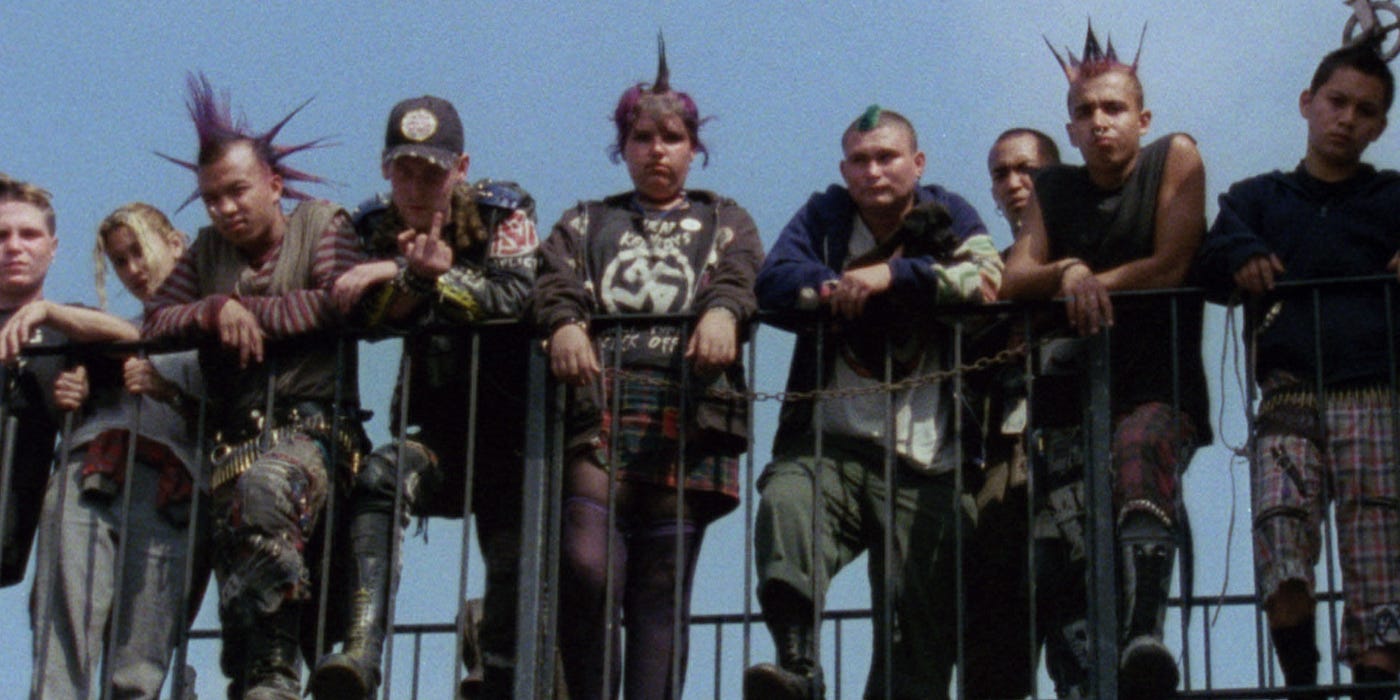
I was just reading that the patriarchal tradition is rooted in destruction, a tradition of destruction. It usurped the feminine or the matriarchal bringing-forth of life, the feminine creativity, women as the creators of life. I want to proclaim that I am against the world, but also myself and the male project of destruction. Might it be endearing to say, “I hate myself because I am a man” or “I self deprecate my position literally and symbolically?” I wish to negate my own position because I am a male voice. But no, this is more of the same destruction. Now is the time to be proactive. And not just productive, not just to make more of the same, but proactive by design. We need a different way of designing worlds. I still do believe wholeheartedly in the potentials of design and of the arts more generally. That’s why I keep doing what I’m doing. I refuse to be a nihilist, as tempting as it might be.
I think nihilism becomes a little boring after a while. Last time we were in Iceland, I think we talked a lot about pessimism. A little bit more fun there. Escobar evokes (Ivan) Illich from time to time, which I like a lot as he is an old hero of mine. I have been reading about coming from a culture that doesn’t really have an *ancestral mandate — *access to all the ancestral knowledge — in the way that he speaks about community and autonomy. Then he says, “even for those of us who are not born in the midst of a community and who have been constructed as individuals by our histories, there is always friendship and love as the seeds to forge new commons.” Very beautiful. I’m thinking about this crafting of decentralized organizational structures and how decentralization still nurtures friendships and love. I think that would be a good design criteria.
With the community of people that I’ve found myself speaking and engaging with more and more these days, it seems like the way that they describe the decentralized paradigm is moving towards radical inclusivity as a new orientation to relationship building based on the wholesome acceptance of the other. This is opposed to a demonized idea of centralization being synonymous with monstrous corporations and top-down, God-king, tyrannical control. When framed that way, I can’t help but think that they’re ultimately trying to inject a matriarchal system into or onto the patriarchal one, although it’s much more complex and nuanced than that. There must be more to it than simply the model of organization.
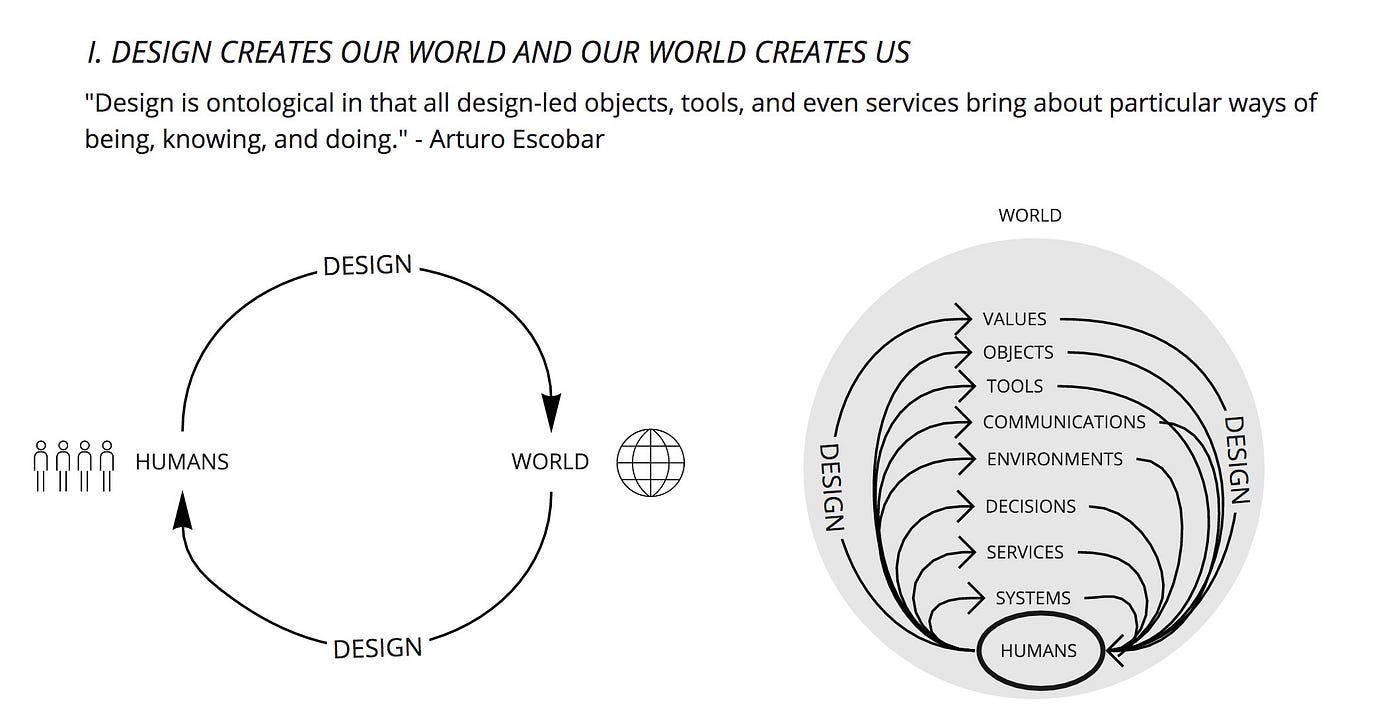
Elsewhere in the introduction, Escobar is setting up this idea of ontological design. He proposes that in this text he will discuss not merely the design of physical things of the material world or of the architectural metaphors of our organizations, but the design of our perspective. I have been personally obsessed with this notion for my entire life; the design of life as an intentional designing of one’s own orientation, reflexivity as a tool and an appendage, rather than as a framework imposed upon life. I would oppose this to the supremely modernist — or even high-modernist — utopian scheme of imposing our idealistic will upon the world. To design oneself from the core, from the middle out, to permeate through all of our contact with the world.
There’s something I have not yet articulated, but I have been imagining. It’s an image of a new kind of responsibility, a new way of articulating individual ethics that is fostered by a decentralized framework. The coordination problem is not simply how to decentralize the means of production for a corporation. The question of coordination must be concerned with how we all engage individually in this new ontological design experiment and then coordinate our findings with each other, between individuals. What kind of new world might that bring about? The New World… we must be careful with such ideas!
Jonatan, what I really want to do is talk to you about the ideas that you think are important right now, right here, in this world. I don’t want to wrangle you into dealing with the stuff that I’m thinking about with others. I want to come to you where you are and figure out how to create space within this project for your perspective. Simply that. Along the way I’ll share with you what I have been exposed to and I have no doubt that we will easily discover synergies between our two perspectives. What do you think about that as a provisional method?
I think that sounds good. I think we should. I think the question of what I find important at the moment is also not necessarily something that I completely have an answer to, but we could speak into it to try and find out. I think it would be nice for me to know what I find important at the moment. Sometimes you’re just not sure because you’re too wrapped up in house building or something, which is important to me at the moment, but I think it’s not necessarily what we’re gonna talk about.
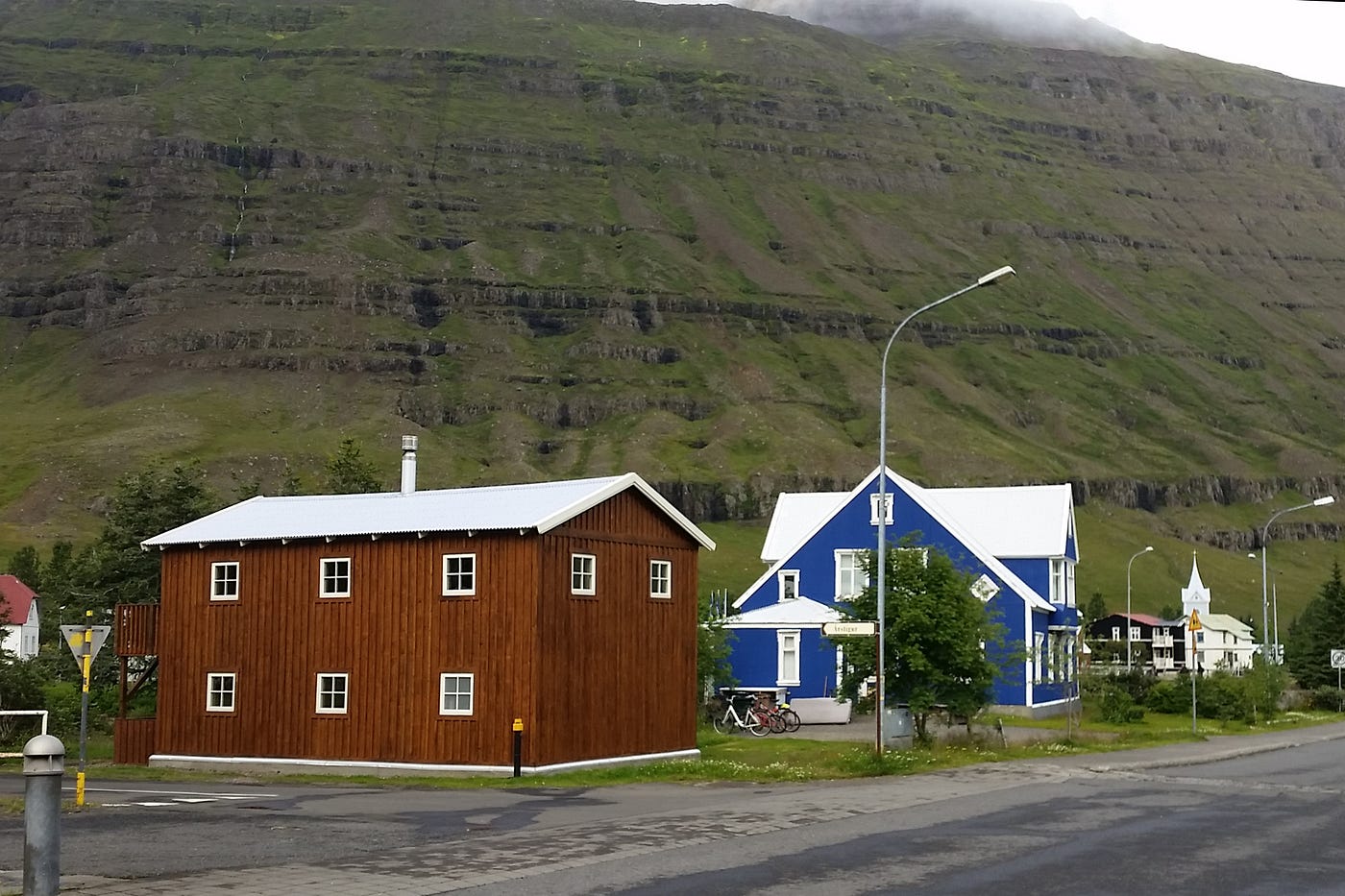
I think it could be. And I definitely don’t think we should avoid talking about the house you’re building.
I don’t want to avoid it either. I think one of the things that has remained important and confusing to me over the last few years, and which remains so, is education and the role of education in a conversation like this one. One of the things that education as a communal space — as a social space — can touch upon and become a space for conducting a conversation about is this element of (not just) the form of an organization, but the ethics that we step into that organization with and the way we live in it actively and the way we carry ourselves into it. I think that’s where these spaces, educational spaces, have an incredibly important role. This could be an entry point for something.
Last time I saw you, I remember spending a particularly dark and snowy day inside the cozy Herðubreið, drinking coffee and going over a text that you had been invited to write. That text was part of a compilation on education and you were writing a kind of synopsis of the LungA school. Is that right? I was just helping you proofread it. I don’t lay any claim to any kind of contribution. It might be helpful to remember the “tangle” issue. It started with a translation problem, didn’t it?
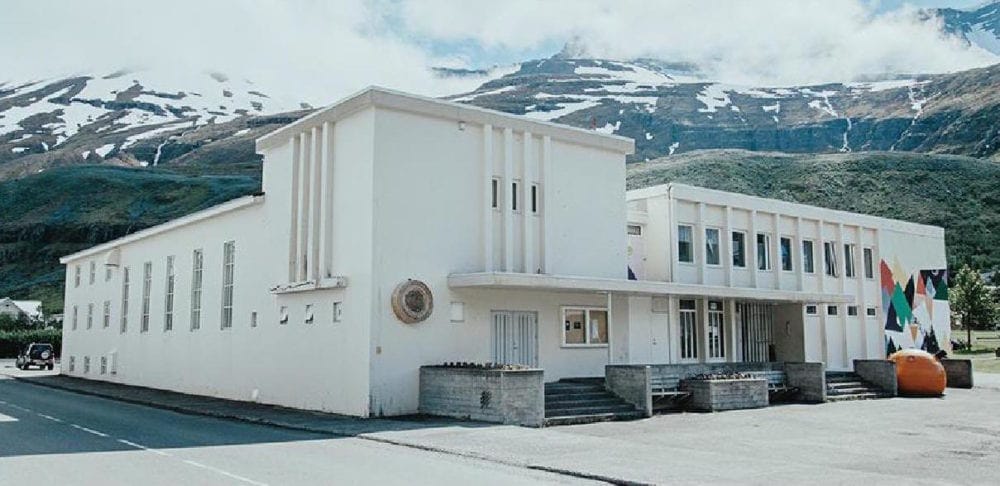
Yes. There was a translation issue and it kept on for some weeks, actually. It became more than an issue. It became a discussion.
What was that about? It was a Danish word that you were using that translated, roughly into “tangle,” but it amounted to so much more than that for you. What is the Danish word for “tangle?”
It’s sammensurium. It means that it’s so messy. The problem with “tangle” is that it feels complicated, but you can still untangle it. Sammensurium is much more, a too-big-of-a-bundle of stuff that’s wrapped together where you would never attempt to untangle it. It would take a million lifetimes. It’s this word that’s just so messy and it’s not just that it’s tangled but that it’s also greasy and it’s crazy. You don’t want to get your hands in there, but you’re in there! It has a bit of texture. You wouldn’t know where to start. It’s in the mud. I really like this word.
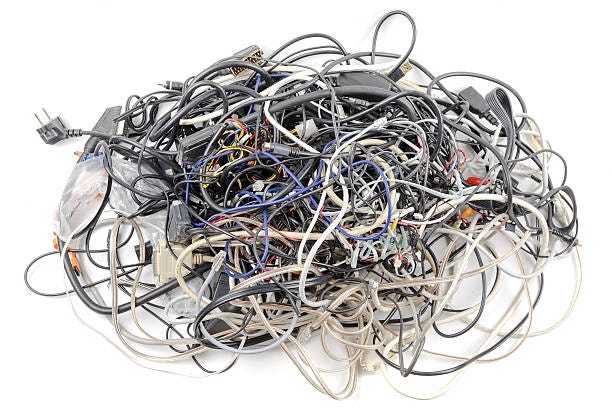
Now I’m writing another text for this folk High School association. I wrote a passage in there about the LungA school that might be one of the better passages I’ve ever written. It’s about what it means to consider the LungA school a performance. At the time I was reading the book that you gave me, the Brian Massumi book about what animals teach us about politics. That book was an eye opener! There were some conceptual openings there, with the conceptual openness that Massumi advocates for in his concept-and situation that was just so helpful. And the way that he describes play building upon (Gregory) Bateson was just incredibly good.
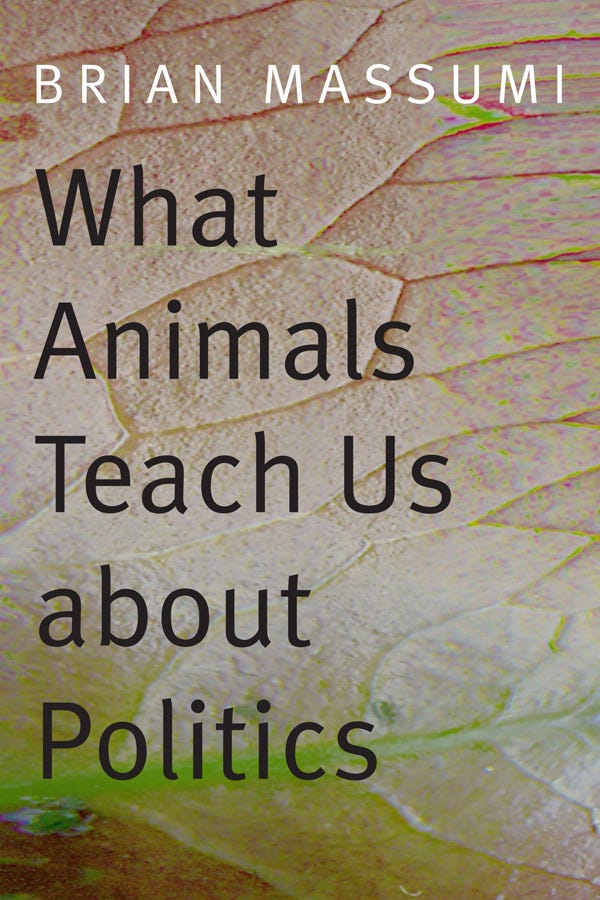
I remember! Massumi was observing and ruminating upon how dogs nip in their pack dynamics and the style of nipping through play. Two pups of the same litter nipping at each other while play-fighting might seamlessly escalate into real-fighting. To an outside observer there is a threshold that is crossed, but it cannot be experienced from the outside. It’s a matter of intensity and style, more than just the mechanical closing of the jaws, rather some strange, ineffable confluence of intention and teeth.
Play is often thought of as a less intense version of something real, an intensity layered on top of and parallel to the real. Massumi argues that play is always more than the activity that it’s invoking, because it is always playing something, but it’s not less of that something it’s more of that something in order for it to be playful. It’s with play that there’s an opening towards that something. It has that something that it’s invoking, but it’s also something else. There are always openings to other things, which is why play is surprising and why through play we can take unexpected directions. It’s only through the practice of playing in the action that the ability to invoke this outside-of-the-concept becomes available.

So this is a passage that’s called The Performance of School-And:
Considering the school as collective artistic practice is structurally communicated through the name of the program 84, a score defining not just the notes, but also the duration: 84 days, 12 weeks. The process of actively considering those 12 weeks as a performative space requires certain mental gestures and a conceptual flexibility. That the 84 days is a performative space does not mean that we somehow pretend to be a school, but really aren’t. It’s also not the case that we act out a school or act as if we were a school. Both of those understandings of performativity are to simplify it and seem to consider performativity as something separate from what it performs. For example, the performance of a school is not a school. What we’re arguing is that the performed activity operates in ways where it is not either a school or a performance of a school, but rather allows the activity to be simultaneously a school and something else. That performed activity — in this case the school, the teaching, and the learning — comes into being as performance by drawing on what it denotes. The open ended concept of a school is brought into being through the articulation of a space of learning and the corporealisation of roles and responsibilities in relation to the space of learning. But the performed activity, while drawing on what it denotes, is clearly also something else. In the same way that a lecture performance is clearly a lecture, but clearly also something else — for example, art — a school performance is clearly a school, but clearly also something else — for example, art. The performance of a school introduces a tension between performing and schooling. A productive tension perhaps, in which what we do is always school-and and never reduced to school-or. The school is always more than itself. And this ‘more’ does not necessarily follow the same trajectory. This is true even to the point where we see no contradiction in the statement that we are simultaneously a school and not a school. The performed activity does not follow laws of non-contradiction, but even relies on the possibility of contradiction if there is to be any room for experimentation and novel creative gestures. The school and something does not produce possibilities through a dialectic relation but are unfolded in each other symbiotically. The importance of considering the school a collective performative practice is exactly this: it’s a way of always — in the lived practice — holding lightly the structures that emerge. It is a way of collectively making room for other voices and logics. It is a way of remaining fluid. And this productive paradox is exactly what nurtures us as artists involved with schooling. This is important if we as an arts institution, and a school, and more, are to cultivate and stimulate environments for integrated conscious social practices dedicated to principles of reciprocity, benevolence, solidarity, cooperation and self governance.
Nicely said. In that passage, the space of learning is not taken for granted as something that is found and adopted from pre-existing structures, but it seems that you are proposing it must be actively created. In the creation of that space of learning and in the willingness to be open to possibilities that constitutes the performing of that space, at the nexus is “where” and “what” becomes-school. It seems to me that all of these terms, of the making of space, even just making, are both literal and metaphorical. I wonder if you mean it this way or if this is just me projecting on your elegant concept. It requires people coordinating locally to physically make space, to reserve and hold space for each other. This is part of the making as both the literal and the metaphorical architecture of the school. This is a cerebral space and a creative space that is unbounded to physical dimensions to some extent, but both are required. A purely noncorporeal creative space would be insufficient for a truly open, inclusive modality of learning. This is where the performance comes in. It’s not merely performance as a layer superimposed upon reality, but it is this also. Not a division between reality built upon terra firma and the role that we play that supersedes reality, not a choice between one or the other, as this is a false choice. You’re imagining of an inclusive making-of-spaces-of-learning mandates that we at least entertain the potential of both, of the and, being ourselves and also performing more-than-merely ourselves. That’s the performance of entering into the other’s perspective. Am I getting that wrong?
I would say you’re getting it quite right.
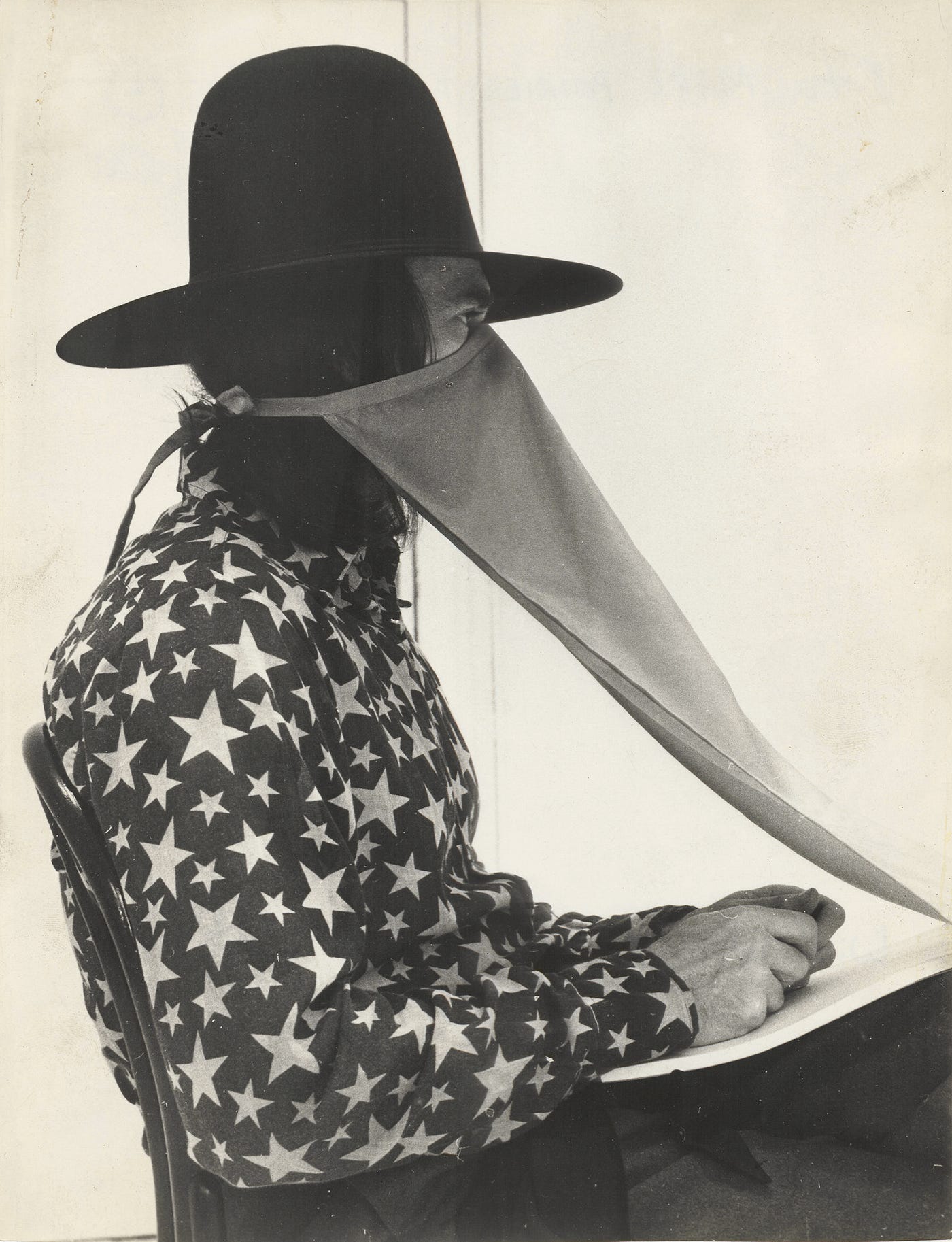
I have so many questions about LungA school and how you have engineered it — dare I say — as a vision, as an architect, as a very powerful example of a successful collaboration and coordination effort, at first with Lasse and now with others sharing the responsibilities. Witnessing the active decentralization of the entire program has been so significant and transformative for me personally, as a person living in this world, and to have been a part of that for a brief time. Now you have rearranged your life a bit. You’re still very much a part of the school, but you’ve taken a step… I won’t say a step back, but a step to the side. I really want to talk about how your new focus feeds into your understanding of what the school was and how it is and your insistence to imagine what it can be and will be, to the extent that it’s a performance that’s still underway.
This thing you mentioned about which direction that I’m stepping, if I’m stepping back or stepping to the side, I think that has been confusing for me to understand: where I’m stepping. What is this that we’re doing and what is it for me? Lasse and I have been doing the school for six years together and there was this feeling that I wouldn’t want the school to be understood as our school, because that so easily happens. It’s still a bit foggy, but it’s condensing as I begin to articulate some parts of it. I thought that one of the ways in which I would address this feeling of not wanting it to be understood as our school was to take a step back, to be more vocal when we are there with a group that has just come together, to explain that this is our shared place that we are making together and this requires assuming responsibility collectively for whatever is going on. I thought that I would need to pull myself out a little bit, to continue to engage a lot with whatever comes from everyone else, but maybe take a different kind of initiative. This resulted in some months where I was very confused about how to act, because that wasn’t how I was used to doing it. I also realized that it didn’t create a situation where everyone felt like it was more their school. It felt like the only way to address this was to not step back, but maybe step to the side or maybe step more in. I think this idea of stepping more into the school has been what has resonated the most, because that’s how you can become part of it, so that it can be its own thing.

If you are in the sammensurium, then you almost can’t be seen because you’re tangled with everything else and you’re full of mud. Instead of the feeling of stepping aside and back, I want the feeling to be that I’m stepping more in because that feels like the only way I can act towards the community as part of the community. I remember very clearly this feeling that the direction I’m going is something I need to understand a little bit better, and that has been very confusing, but in my body I feel like I’m going more in there. I’m not sure what that looks like, since I felt like I was pretty much already in there, but since the structure has changed I need to get in there in a different way and go in there again and again. That’s also part of it. It’s not like you go in and then you’re in. It’s a constant decision and action towards getting in there.
I wanted to go back to this image that you just evoked for me. When you’re in the sammensurium, you cannot be seen, a kind of negative image or a vision of obscurity. The more you go into the center, the less the individual identity is emphasized. This evokes a strong connection to the importance of anonymity and the fragility of identity. When I was a guest artist at the LungA school I was personally very preoccupied with the ontological foundation of identity itself, what I called ‘existential concentration’ on myself as merely one unit among others. I was developing an art of utilitarian dissociation… and I’m not trying to get into that, per se, but what I found while I was there was that the harder I tried to focus upon identity, the less relevant it felt. There was an amazing group of individuals there that had wonderful and beautiful personalities, and yet that all loosened and began to melt away. I have this image of smelting, a hot soup of alloys. When we’re separate we’re cold and condensed. There’s aluminum and there’s steel and there’s bronze, called by their proper names, but when we come together in the heat of the center, into the flame, it all becomes volcanic, becomes magma.

You’re emphasizing the optical quality, which I don’t want to brush aside. In the sammensurium you become less visible, less of an aesthetic object. I’ve been thinking a lot about privacy. People are very concerned with privacy for many different and oftentimes contradictory reasons. What I find myself returning to is the relationship — or tension, or entanglement — between anonymity and autonomy. Remaining anonymous, being unseeable or refraining from revealing oneself, is related to our ability to act autonomously, to exercise individual sovereignty. Our identities are bound by our potential to be identified, to be bound to the personage that precedes our being, to be differentiated from the tangled, muddy mass. So if you were to step aside perhaps you would be calling more attention to yourself, effectively becoming more visible and easier to identify as an agent and diminishing your potential contribution to the group. Stepping into the center, stepping forward, diminishes the importance of your singular role and proliferates agency for everyone else involved as a performative and collective action. Let’s all step more into the center!
It’s really fun to think about anonymity and autonomy, the different kinds of autonomy and the different directions one can step. Returning to the Arturo Escobar book, the kind of autonomy that comes from stepping into or towards the center — what you call smelting — the kind of autonomy that Escobar is addressing is inherently communal. It is not an autonomy that is equal to individualism in any way. Whereas if you’re stepping away you’ve become more visible and the kind of autonomy gained in that space has to struggle more to become relevant to the community, because it’s not by default communal. You have to actively proclaim, “this I’m doing for the community and this I’m not doing for the community.” Whether it’s for the community or not becomes a thing you have to choose. But when you’re in there, it is embedded in the actions. It’s not a choice whether it has communal consequences or relevance.

There is something really interesting about — not removing the communal, but — removing the choice of it, so that it’s not something that you’re choosing in every action. It’s embedded in every action because you already moved into the center. This is also a way of eliminating choices or taking decisions that have consequences on larger scales so you don’t have to think about them in every decision. Lasse and I have talked a lot about making decisions that have influence on so many things, like deciding to move to Seydisfjordur. It has had such an influence on so many aspects of my life and now there’s so much that I don’t have to think about since there are so many possibilities removed, but also so much given. It’s a simplification; by removing something and by making some things given. Yet, it doesn’t feel like the space of acting is smaller. It still feels endless. It creates space for more interesting thoughts. The important stuff — the ontological stuff and the ethical stuff — is built into the situation so it doesn’t have to be a choice every single time. It’s not that “oh now I’m here and I don’t have to think about it.” You always have to think about it, but — and this is where the design part comes in — that it can be built into the situation.
You’re making me think of constraints, this buzzword that designers use quite often. We design into the constraints of a particular project, because without boundaries — with an infinite potential of possibilities — how does one even know where to begin? How do we know how to make decisions? Although this might be received as industry lingo concerning how to technically execute a design solution in relation to a clearly identified problem, this is also a very important idea philosophically. When we design for the universal it always surpasses and excludes the needs of the local. A better design, which is to say how we might determine the fitness of a design ethos, would be to design locally for a very specific problem and then to adapt the successful solution to other places in relation to the unique problems that arise there. Design needs to be contextualized to remain relevant, concerning the space that supports it and the integration with local applications. So you moved to a small fishing village on the brink of oblivion wedged between a mountainous monument of geology and the infinite void of greyscale space and built a house right where the ocean meets the clouds, entangled with the breathing motions of the world, the inhalations and exhalations flowing in and out of the fjord. This location and this project create the circumstances for recognizing that all the things this place is missing is what creates the profound potential to live differently, to design another way of living.
This series is made possible by a generous grant awarded by MolochDAO. Thank you Moloch!